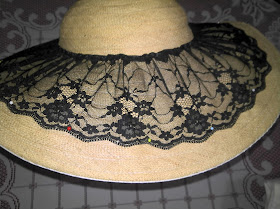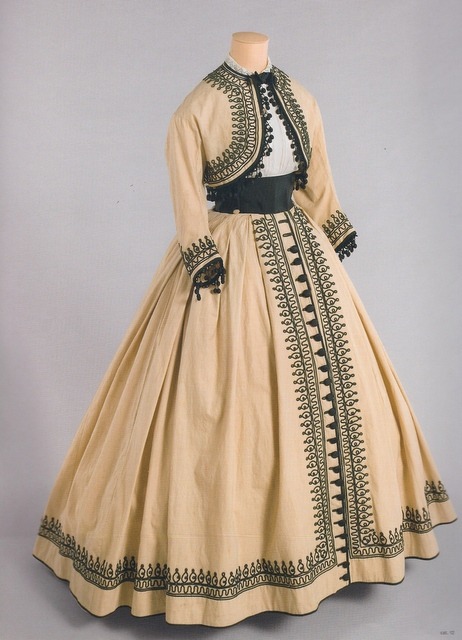I have yet again been slow to post projects. I am currently spending most of my time working and stressing over my thesis, which is due far too soon for my liking. This year has gone very fast. Two weeks ago I finally started work on my green drawn bonnet that I had been planning for well over a year. The Historical Sewing Fortnight Challenge #21 Green gave me my final motivation.
As I had been thinking about this for a long time I had collected a lot of inspiration on my
pintrest board. My main inspiration came from the following two bonnets. I loved the ruffle over the brim of the poke and the bow with the biased edges and lace of the capote bonnet.
Poke Bonnet circa 1860 at the MET Museum
Woman's Capote Bonnet circa 1857 LACMA Collections
This was an interesting project as I kept changing my mind over the design and construction methods. In the end I settled on making only this back drawn over a set form. I figured that it would be very easy to go over the top, and with the colour choice being so vivid it may not be the best. So I reined in my imagination and chose a few features that I really loved.
I also noticed when researching that there are not many blog posts that detail how people construct their bonnets. From personal experience of trial and error, workshops and reading heaps I have found there are many ways to construct bonnets and I really still do not know if there is a 'correct' or 'only way'. With my time limitations at the moment I decided to take a few short cuts that I have not previously taken.
Sorry about the bad photo, I did not notice till later that I had it pinned on crooked. Also my head form is very small... my head is a lot larger.
To begin with I used some buckram from my stash and created a form from the pattern I used for my wedding bonnet. It is not as high at the top as some and has a distinct joining from the back to the brim. I fount that this pattern suited me. It is more of a shape for the late 1850s and early 1860s and would probably be outdated by 1862, depending on how fashionable you are feeling. The shapes were hand whipped to millinery wire beginning at the back and working forwards. Some of my friends hate this part, but I find it is a very enjoyable way to spend the evening on the couch while watching TV. Once the shape was formed and looked correct, I covered it with a layer of quilters cotton batting. This I also whipped stitched on.
I then started to work on covering the bonnet. I always cut about an inch seam allowance over the shape pattern as with bonnets it is best to be safe rather than sorry. Especially as I usually use small scraps of silk in my bonnets.
The green silk is attached using tacking. I do not worry about it too much as it will be stitched tighter in the next stage.
I then had to work out how much fabric would be required to cover the bonnet in the drawn style. Thankfully I had a lot of advice, a pattern from an original from a friends collection to work with. So I had a heads up on how much to approximate.
My drawn pattern piece
What I did, however, was trace the pattern piece using cheap baking paper (95 cents a roll). I then measure the diameter of the cane (in this case it was just under half an inch, bout 1.2 Cm's... always be generous... sorry I didn't keep my exact measurements. I suggest wrapping some string around the cane then measuring with a ruler). I worked out how many times I wanted to draw it over cane (so I multiplied the diameter by number of canes to be used) then added extra fabric for spare. When fabric is drawn it needs a little extra give or it pulls too tight. I also needed to add in the seam allowances that are not included on the pattern. Then I needed to work out how much to add to the width for the gathers... this I estimated by gathering a bit of the waste fabric to 1 inch then work out the difference. I then cut my backing paper pattern at each 1 inch point and added the extra measurement. Complicated to explain, but easy visually to work it out and do (for me).
Next I had to draw the fabric over the cane. I cheated at first, using my machine with the piping foot. This is a very fast method, but does become more difficult as you add extra canes.
By the time I reached cane number 5 I gave up and decided to finish it by hand using a simple running stitch.
Next was the hard part. This is because cane is not overly flexible and can break... which can cause issues. I suggest soaking the drawn cane with a spray bottle when pinned onto the bonnet and leave till dry. This is because you cannot shift the gathers when the silk is wet... it grips the cane too much. Also once the cane changes shape to fit and curve better they will have to be moved and adjusted into place again. I have tried using easier methods such as piping cord and thin rope in the past but it is had to get the clean gather lines that the cane provides. The cane also makes the bonnet very strong.

I gathered the silk along the cane and cut the cane till it reached the spot I wanted. I then put a pin through it to hold it into place until I had hand stitched it down. I also stitched through the cane to ensure it was stable and did not move. Cane is a soft wood and not that hard to sew through, but I do advice putting your needle in emery as you go so that it does not become blunted too much.
I folded about half an inch of fabric under the cane as a seam allowance.
This shows how the needed went into the cane to stabilise its position.
One side complete
It is also important to sew along each cane to set its position.
Next comes the covering of the brim. I always start at one side and work my way around. I also add a lot of fabric to the pattern to ensure that the fabric goes over the brim and has enough length to pull down into the front as a one piece covering.
This is all hand sewn using small whip stitches. I also have gathering stitches along the inside to draw it into a nice gather.
I fully attach it from the outside first. Sometimes I will make the outside part gathered, but for this design I kept it flat and fitted.
I then pull the gathers in tight and pin prick stitch into place along the outside seam line.
I kept the cover of the brim plain as I had made a ruffle. I measured how wide I wanted it, then I sewed it into a tube and piped it with the tube seam about 1/4 inch next to the cane on the under side to hide it. I then attached it to the bonnet the same as previously. I did consider putting two on, but I chose to be restrained.
Then it was time for the bavolett. This was simply cut from my pattern with a little extra added. It has net on the underside and the edge is bias taped using home made silk bias. I then sewed it into place and gathered it at the top.
As I wanted this to be a very special bonnet I decided to line it. I really have never done this before as I do not see he need. I used some scrap ivory silk and whipped it at the top into place and then made a tube on the inside that could be drawn with ribbon. Sorry my brain is a little fried on my thesis... so my technical language is dead. The only advice I will suggest is making sure that in lining you have enough fabric that it pushes out and does not cut into the space inside the bonnet, so your hair will still fit.
When decorating my bonnets I try lots to get it just right. I normally place flowers, pin them into place, photograph them then take them off to sew. I also cut off any plastic and wind up any wires so they don't scratch my head.For this bonnet I also tacked on some lace using a curved needle. This means that the lace is only attached to the silk and not the frame. I also chose not to put flowers on the outside of the bonnet.
I also always like to check the fit before finalising my design... always careful of pins though.
To finish I decided not to use ribbons but make them from the left over silk to create a perfect match. I always draw a template on paper for this. I have done this as I plan to do more to this bonnet later. Due to time I wont be able to finish it fully until next year. I have the bow from the example above half made. I hope that in the holidays I will be able to use some ivory cotton to crochet lace directly onto the bow and maybe even onto the ribbons for tying it up. But for now I love it and cant wait to wear it to the events I have coming up in the next few weeks. It will look stunning with my matching apple green shawl.
The Challenge 21# Green
Fabric: Green Silk
Notions: Cane, Buckram, Cotton Thread, Ivory Cotton Lace, Flowers, Millinery Wire
Pattern: From Wendy Tonzing, The Undertailor
Year: 1858-1861
How historically accurate is it? I think it should be fairly accurate, I did cut some corners with the sewing machine, the buckram is not the same as the period type, the red flowers also have plastic stalks... depends on how picky I choose to be really.
Hours to complete: about 18, but I had company for most
First worn: Still awaiting that moment
Total cost: Most came from my stash, but I did need to purchase new wire, which I used to make 3 frames at $10 a roll. Its always hard to price stuff that you payed for a long time ago... I would guess about $80 all up.




































































